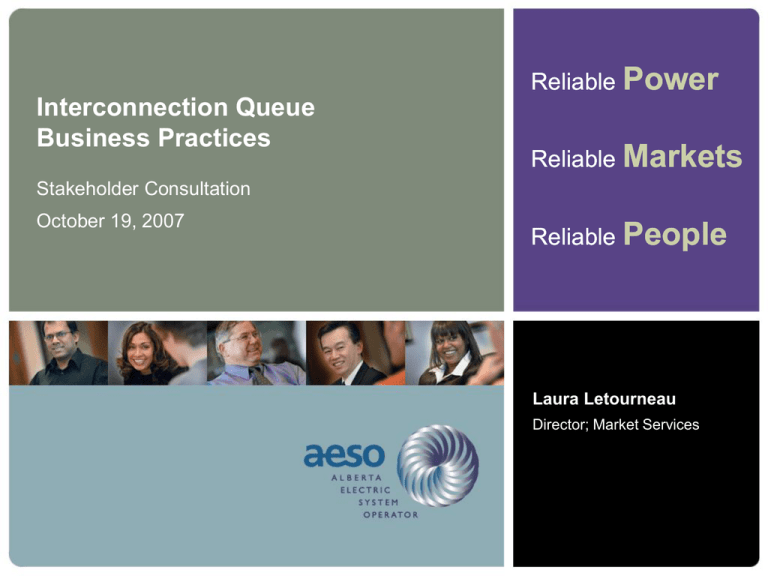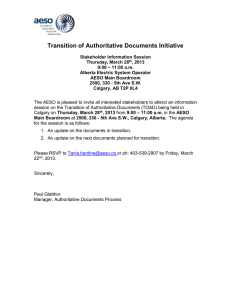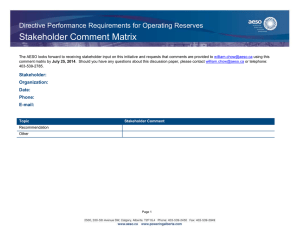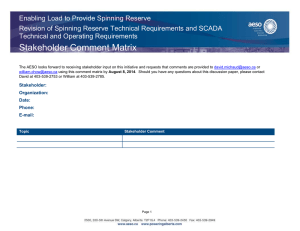Power Markets People Interconnection Queue
advertisement

Reliable Power Interconnection Queue Business Practices Reliable Markets Stakeholder Consultation October 19, 2007 Reliable People Laura Letourneau Director; Market Services Welcome & Background • Interconnection Process and Queue Management has developed/evolved over past several years. Although interconnection process is generic it has been impacted by wind integration challenges. – Interconnection Process developed through consultation in 2005 – Interim practices established to accommodate customers during transition from 2003 to 2005/6 tariff – April 2006 – start temporary 900 MW reliability threshold on wind – May & June 2006 - stakeholder consultations; response posted September 2006 – Fall ’06- Sept ’07 – develop/consult/finalize Market & Operational Framework (MOF) – September 2007 – Threshold replaced by MOF/ Queue Discussion Paper 2 Today: Agenda & Expectations • Interconnection Queue Business Practices (Shaun Andrews) – Review/clarify the published discussion paper – Full consultation on proposal (paper/presentation) therefore publish comments and response matrix – Expectation • refinements rather than major overhaul • Finalized business practices by December ‘07 • Plan for Workload Management (Jana Mosley) – Inform Stakeholders of the AESO Plan to manage work volume – Not part of formal Interconnection Queue Consultation therefore comments/suggestions welcome but informal process Unless clarifying understanding, please hold questions/comments to end All questions/comments and responses will be documented and published 3 Reliable Power Interconnection Queue Business Practices Stakeholder Consultation Reliable Markets Reliable People October 19, 2007 Shaun Andrews Customer Interconnections Purpose of the Meeting • Review background and need for proposed modifications to the interconnection process business practices • Present and explain key elements of the proposed changes • Review some of the alternatives that were considered • Discuss next steps 5 Background • Interconnection Process and Queue designed to facilitate open, non-discriminatory system access • In May 2006, the AESO conducted a stakeholder session proposing project milestones • Consulted with industry over the last year • Developed a generation queue to address transparency, workload, and threshold issues 6 Current Environment • Currently: – “Current Cash Committed” projects (those that provided their Customer Contribution in the form of cash under a Construction Commitment Agreement (“CCA”), are positioned according to the date of customer commitment – “Uncommitted” projects are positioned according to the date of the customer’s Preliminary Assessment Application – Higher queue position assigned to “committed” projects – Lack of project progress milestones Unintended Consequences: – Inconsistent with efficient and non-discriminatory interconnection process – Increased uncertainty for generation development – Lack of progress on projects 7 Proposed Modifications • Proposed modifications designed to ensure that projects are progressing, capacity is allocated effectively and customers are dealt with fairly and consistently – Project sequence will be established at the time the customer’s Preliminary Assessment Application is submitted – Milestones tied to interconnection process versus project – Customers must meet milestones in order to maintain their Queue Position – Failure to complete Interconnection Process Milestones will result in cancellation of the customer’s application – Cancelled projects can be re-initiated with a submission of a new Preliminary Assessment Application and fee 8 Benefits of Modifications • Address concerns regarding outside influences (i.e. AESO responsiveness) impacting project Queue Position • Eliminate ”queue jumping” (advancing Queue Position) • Increased confidence in project progression improves efficiency of conducting transmission planning studies • Clear milestone triggers, obligations and consequences facilitate more efficient progression of interconnection projects 9 Consistency: Policy, Regulation, Legislation & Tariff In relation to assigning transmission capacity at time of a Preliminary Assessment Application: • Removal of other influence on queue position/priority aligns with open access principle • Allocation at early process stage is consistent with policy direction regarding “proactive” transmission planning 10 Consistency: Policy, Regulation, Legislation & Tariff In relation to project milestones and non-compliance: • Transmission Development Policy states generators “may not prohibit interconnection or access … by other generators or loads.” • Section 16 (3) further reinforces the intent to not “block access” • TDP recognizes “significant milestone dates in a generation project schedule” and envisioned that “the ISO will be required to identify suitable generator project milestones” • 2006 AESO Tariff contains language with regards to “critical milestones” for projects and states that if the customer fails to meet such milestones, the AESO may cancel and require the customer to resubmit a Preliminary Assessment Application 11 Alternatives Considered • Right of First Refusal (if queue priority was changing) • Project “Stalling” • Publication of Interconnection Queue 12 Milestones Project initiated by submission of Preliminary Assessment Application (PAA) Trigger Milestone 1. AESO notifies customer of data deficiency on PAA 1. Submit required data within 30 days of AESO notification 2. AESO issues Interconnection Proposal to customer 2. Submit written acceptance of the proposal within 60 days 3. Request technical data needed in order to support need filing 3. Submit data within 60 days of request 4. NIF is filed by the AESO and approved by the EUB 4. Sign a CCA within 60 days of NIF approval 5. Invoice the customer for system contribution as well as customer contribution 5. Pay the system contribution and customer contribution within 90 days of receipt of EUB Permit and License. 6. AESO prepares System Access Services agreement 6. Sign agreement 42 days (6 weeks) prior to energization 13 Implementation • Implementation of the Proposed Business Practice modifications must address the following issues: – Ensure fair treatment of existing projects by minimizing customer impact – Ensure all impacted stakeholders understand their obligations under new business practices – Pursue specific tariff amendments in order to more clearly and explicitly align the terms and conditions of AESO Tariff and the business practices 14 Queue Position & Transmission Capacity Allocation • Current Cash Committed projects – retain existing queue position established by payment date of the customer contribution, provided financial and progress/milestone obligations are maintained • Uncommitted projects – retain queue position established by Preliminary Assessment Application submission date, provided progress/milestone obligations are met • New application – establish queue position based on Preliminary Assessment Application submission date 15 Noncompliance - Project Cancellation • All Projects: – If the customer does not meet progress milestone obligations, the project will be deemed cancelled, the customer application fee will be forfeited and transmission capacity allocated to the cancelled project will be reallocated • Current Cash Committed Projects: – If customer does not maintain their financial obligations, the project will no longer be classified as “committed” and will revert to “uncommitted” status and be repositioned in the queue as per the date of the Preliminary Assessment Application *AESO working on notification process 16 Next Steps • Discussion paper posted September 26, 2007 • Written comments due to the AESO (laura.letourneau@aeso.ca) by November 2, 2007 • Review and publish stakeholders’ written feedback • Finalize and publish: – AESO responses to written feedback – Final Interconnection Process Business Practices • Pursue tariff amendments as needed to align Tariff terms and conditions with effective business practices 17 Questions 18 Reliable Power Wind Application Workload Management Stakeholder Consultation October 19, 2007 Reliable Markets Reliable People Jana Mosley Operations Assistant to the VP, Transmission Overview • Customer (& AESO) concerns • How will we address these concerns? – Resourcing – Work Plan • High level process • How the queue applies 20 Customer (& AESO) Concerns • Work has not started on my project • I need to know when I can connect my project • How will the AESO resource all of these projects in the queue? • What will I be getting from the AESO in return for my Preliminary Assessment Application? • How will the project queue apply to AESO workload management? 21 Resourcing • Currently finalizing Interconnection Proposals (IP) for projects that had applied prior to the 2006 Tariff • Moving forward….. – AESO System Planning has hired an experienced consulting company to provide 4 full-time resources to focus on southern Alberta system reinforcement and wind farm interconnections – Offer customers an IP that is faster to produce with higher level cost estimate – Shaun Andrews will coordinate all wind interconnection projects wanting an accelerated IP until a project manager is later assigned 22 Immediate Work Plan 1. System Base Cases to be finalized (by Dec 7/07) 2. For each project, inform customers if transmission reinforcements are required to provide unconstrained access (by Dec 14/07) 3. Group projects into zones 4. Apply the project queue to each zone 5. Sit down one-on-one with customers - where you are and when an IP could be ready (by Dec 21/07) 23 Immediate Work Plan (cont’d) 6. Customer chooses how detailed they want the initial IP 7. Where requested, prepare simplified IPs that include load flows, +/-50% estimate, high level RAS requirements on customer’s preferred alternative (targeting ~one week per IP) 8. Upon customer acceptance of IP, assign a project manager and proceed through rest of the process 24 Simplified Beginning Process (Optional) Application Process Application Setup/Initiate Project Identify Interconnection Alternatives Select preferred alternative Customer Proposal (IP with Power Flow Only, +/- 50% Estimate, Possible Constraints/RAS) Customer Acceptance Assign a Project Manager & Continue with Regular Process Complete Dynamic Analysis and Finalize NIF 25 How the Queue Applies • Queue is used to order projects in a specific zone – Workload – RAS • Examples: – Project A applies before Project B. Project B does not require system reinforcements to connect Planning could begin on Project B before Project A. 26 Another Example • Projects are ranked in the queue in the following order: A, B, C, D • Projects A, C, and D (Zone 1) would be grouped together to ensure an accurate and complete planning model • Project B (Zone 2) • Project B could finish ahead of Project A, or behind Project C and D. ZONE 1 ZONE 2 Project A Project B Project B Project C Project D 27 Contact Info • For questions relating to this work plan, you can contact Jana Mosley Jana.mosley@aeso.ca Ph: (403) 539-2713 28 Questions 29




